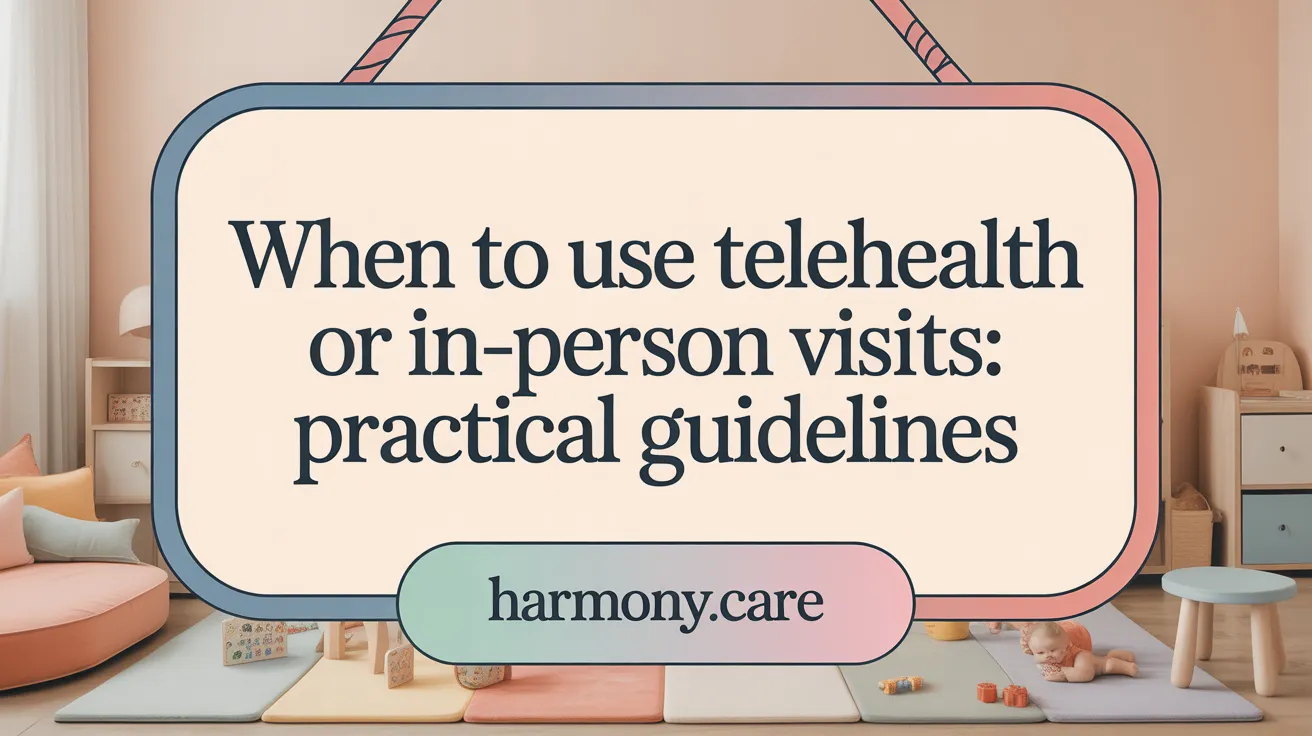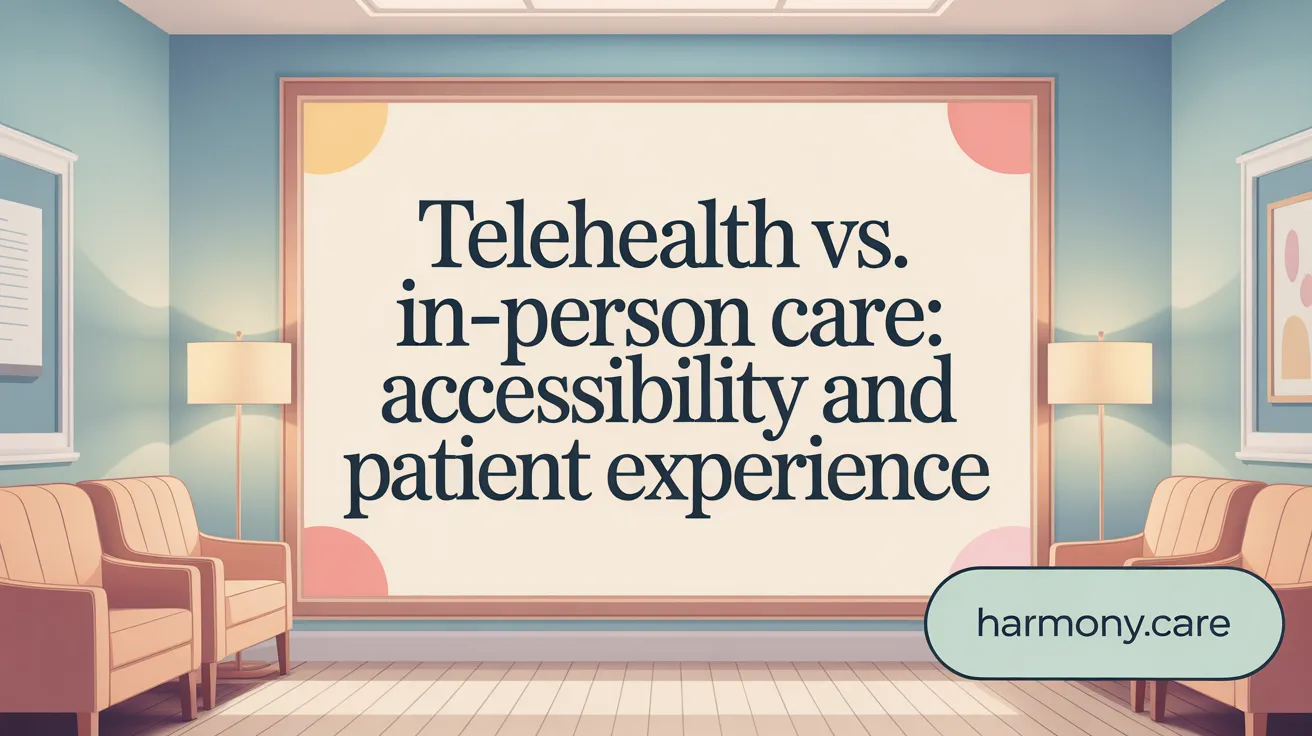Understanding the Shift in Healthcare Delivery Modes
The landscape of healthcare delivery has evolved significantly, with telehealth emerging as a convenient alternative to traditional in-person home visits. Patients and providers are increasingly faced with decisions about which mode of care best addresses medical needs, balancing accessibility, effectiveness, and personal preference. This article explores the critical factors influencing the choice between telehealth and in-person home visits, providing insights into their respective roles, benefits, limitations, and appropriateness across various healthcare scenarios.
Defining Telehealth and In-Person Home Visits: Modes of Healthcare Delivery

What is telehealth and how does it differ from in-person home visits?
Telehealth is a broad term that describes the use of digital communication tools to provide healthcare services remotely. It includes virtual visits via video calls, phone consultations, remote monitoring devices, and secure online patient portals. This mode of healthcare delivery allows patients to consult with healthcare providers from the comfort of their homes or other convenient locations, making access easier, especially in remote or underserved areas.
In contrast, in-person home visits involve healthcare professionals physically traveling to a patient's home to conduct examinations, perform tests, and deliver treatments that require direct, hands-on interaction. These visits enable providers to perform physical assessments, immediate procedures, and deliver certain therapies that cannot be done virtually.
Technologies and settings involved in both modes
Telehealth Technologies include:
- Video conferencing platforms for real-time virtual consultations.
- Mobile health apps for tracking health data and medication management.
- Remote monitoring devices like blood pressure cuffs, glucometers, and pulse oximeters.
- Secure messaging systems and patient portals for follow-up and information sharing.
In-person home visits involve healthcare workers visiting the patient's residence equipped with medical tools, tests, and necessary supplies to conduct thorough physical assessments and interventions.
Modes of healthcare delivery comparison
| Aspect | Telehealth | In-Person Home Visits | Details and Examples |
|---|---|---|---|
| Primary Mode | Digital communication | Physical presence | Telehealth uses apps, video, and remote devices; in-person involves on-site provider visits |
| Suitable for | Routine follow-ups, minor illnesses, chronic condition monitoring | Complex or urgent health issues, physical examinations, procedures | Telehealth handles stable, manageable conditions; in-person is essential for serious or physical assessments |
| Benefits | Accessibility, convenience, reduced travel, safety during infectious outbreaks | Personal connection, immediate hands-on care, physical exams, diagnostic testing | Both platforms complement each other, ensuring comprehensive patient care |
| Limitations | Cannot perform physical exams, requires good internet, technical skills | More resource-intensive, less accessible in remote areas | The choice depends on health needs, location, and comfort with technology |
Understanding both telehealth and in-person home visits allows healthcare providers and patients to make informed decisions tailored to individual medical requirements and circumstances.
Factors Influencing the Choice Between Telehealth and In-Person Visits
 When deciding whether to opt for telehealth or in-person medical care, several considerations come into play. Understanding these factors helps patients and healthcare providers choose the most appropriate setting for treatment.
When deciding whether to opt for telehealth or in-person medical care, several considerations come into play. Understanding these factors helps patients and healthcare providers choose the most appropriate setting for treatment.
First, the medical condition’s nature and urgency are crucial. In-person visits are irreplaceable for situations necessitating physical examinations, such as assessing new or serious symptoms, performing diagnostic tests, or conducting procedures. For example, urgent care cases like leg fractures or severe infections typically require direct medical intervention.
Second, patient preferences and comfort with technology significantly influence the decision. Some individuals may prefer virtual visits for routine follow-ups or managing chronic conditions, especially if they have mobility issues or live in remote areas. Conversely, others may feel more reassured by face-to-face interaction, especially when discussing sensitive health issues.
Cost, convenience, and accessibility also weigh heavily in the choice. Telehealth often reduces expenses related to travel, parking, childcare, and time off work. It allows easier scheduling and access to specialists who might not be locally available. For patients facing geographical barriers or transportation challenges, virtual visits provide a practical solution.
Lastly, the experience level of healthcare providers, along with clinical guidelines and safety protocols, influence the mode of care. Some specialties, such as psychiatry, show high diagnostic concordance via telehealth, making virtual visits suitable. Other fields, like dermatology or ENT (ear, nose, and throat), may require physical exams that only in-person visits can provide. The provider’s familiarity with telemedicine technology and adherence to clinical standards ensure effective and safe care.
In summary, selecting between telehealth and in-person appointments depends on evaluating the urgency and type of health concern, personal comfort with digital platforms, economic factors, and professional medical recommendations. A personalized approach ensures that each patient receives safe, effective, and appropriate care tailored to their individual needs.
Appropriate Use Cases for Telehealth and Home Visits

When is it appropriate to use telemedicine instead of an in-person healthcare visit?
Telemedicine is well-suited for managing minor health concerns and routine follow-ups that do not require physical examinations. Conditions like sore throats, allergies, colds, flu, skin rashes, sinusitis, or respiratory infections can typically be diagnosed and treated through virtual visits.
Patients managing chronic conditions such as diabetes or hypertension often find telehealth effective for regular check-ins, medication adjustments, and lifestyle counseling. Virtual care is also pertinent for acute issues that can be assessed visually or through patient-reported symptoms, including abdominal discomfort, headaches, or minor injuries.
During emergencies or when symptom severity escalates—such as difficulty breathing, chest pain, or sudden loss of consciousness—providing in-person care is essential. Telehealth offers the advantage of accessibility outside normal office hours, enabling patients to seek care during evenings, weekends, or holidays without the need to travel.
Pediatric and women’s health issues also benefit from telehealth, especially for behavioral health concerns, birth control consultations, reproductive health advice, and routine developmental check-ups. Parental oversight ensures safe and effective care for children, with virtual visits supporting mental health, minor skin conditions, or developmental questions.
In summary, telemedicine is an efficient, accessible option for everyday minor health issues, chronic disease management, and non-urgent concerns. However, serious symptoms or complex diagnostic needs warrant in-person evaluations for accurate diagnosis and immediate treatment.
Effectiveness and Outcomes: Comparing Telehealth and In-Person Care

Is telehealth as effective as in-person healthcare visits?
Research indicates that telehealth can be as effective as traditional in-person visits for many medical situations. In mental health care, cancer consultations, and certain specialties, studies show similar outcomes in symptom management, patient satisfaction, and diagnostic accuracy.
For example, a Mayo Clinic study involving nearly 2,400 patients found that diagnostic concordance—meaning how often diagnoses via telehealth matched those in face-to-face visits—was around 86.9%. Specialty areas like psychiatry had even higher concordance rates, while fields relying heavily on physical exams, such as dermatology and otolaryngology, saw lower rates.
Patients report comparable satisfaction levels with telehealth, especially when ease of access and convenience are prioritized. Telehealth makes follow-up appointments for stable chronic conditions more manageable and may improve adherence to care.
However, existing studies face limitations, such as small sample sizes and varying methodologies. These gaps suggest a need for more comprehensive research. Overall, telehealth’s effectiveness depends on the clinical context. It performs well for routine monitoring, mental health counseling, and minor illnesses.
While promising, some areas that demand thorough physical exams or diagnostic tests—like emergency care, imaging, or complex surgeries—still require in-person visits. Diagnostic concordance remains lower in specialties dependent on direct palpation or specialized testing, highlighting the importance of selecting the appropriate visit type based on individual health needs.
In summary, the evidence supports telehealth as a viable, effective alternative for many healthcare services, especially when physical examination limitations are acknowledged. It enhances accessibility, patient satisfaction, and often, health outcomes, but must be complemented with in-person care when necessary to ensure comprehensive treatment.
Patient Characteristics and Preferences Shaping Care Delivery Mode

How do patient characteristics and preferences influence the choice between telehealth and in-person care?
Patient choice between telehealth and in-person medical visits is shaped by several individual factors. Age is a significant determinant; older adults, especially those with multiple chronic conditions, often prefer in-person visits to benefit from physical examinations and comprehensive assessments.
Race and ethnicity also influence preferences. For instance, studies show Black patients are more likely than white patients to choose telehealth options like video and telephone consultations, possibly due to accessibility or cultural considerations.
Geographic location plays a role, with patients residing in areas with higher internet access more inclined to opt for video visits. Those living farther from healthcare facilities or facing transportation challenges tend to favor telehealth for its convenience.
Technology access and prior experience significantly impact choices. Patients with reliable internet, ownership of smartphones or computers, and previous positive telehealth encounters are more likely to utilize virtual care.
Comfort levels with technology and virtual interactions vary. Some patients prefer the familiarity and personal connection of in-person visits, especially when dealing with complex or sensitive health issues. Conversely, individuals seeking convenience or managing chronic conditions remotely often favor telehealth.
Mental health needs also influence preferences. Virtual care can be particularly appealing for mental health services, providing anonymity and ease of access, especially for those hesitant about visiting clinics physically.
Cultural factors, personal comfort, and specific health circumstances all contribute to shaping these decisions. Patients often weigh the convenience and safety of virtual care against the thoroughness and reassurance of in-person visits.
Overall, understanding these individual characteristics helps healthcare providers tailor services that better meet patient needs and improve care experiences.
| Factor | Influence on Care Preference | Additional Details |
|---|---|---|
| Age | Older adults favor in-person for physical assessments | Chronic condition management often requires physical exams |
| Race and ethnicity | Cultural and accessibility factors influence choice | Black patients more frequently opt for telehealth |
| Residence and location | Rural or remote residents prefer virtual for convenience | Increased use in areas with limited healthcare facilities |
| Technology access | Reliable internet and device ownership increase virtual care use | Prior experience boosts familiarity and acceptance |
| Comfort with tech | Varies; some prefer personal interaction over screens | Especially important in sensitive or complex health issues |
| Mental health considerations | Virtual options reduce barriers for mental health services | Anonymity and flexibility are appealing |
What Factors Affect Who Uses Telehealth Versus In-Person Visits?
Population demographics, technological infrastructure, and individual health needs significantly influence whether patients prefer virtual or physical visits. Recognizing these factors ensures more personalized and accessible healthcare options.
Risks and Limitations of Telehealth in Healthcare Delivery
What are the common risks associated with telehealth?
Telehealth offers many advantages, but it also comes with certain risks and limitations that healthcare providers and patients need to consider.
One of the primary concerns involves technical challenges. Reliable internet connectivity, functioning hardware, and effective software are essential for smooth virtual consultations. Disruptions such as connection failures, hardware malfunctions, or software glitches can interrupt or delay care, sometimes leading to incomplete assessments or misdiagnoses.
Privacy and security are significant considerations. During virtual visits, patient data is transmitted electronically, making it vulnerable to hacking, unauthorized access, or breaches. If cybersecurity measures are not robust, sensitive health information could be compromised, posing risks to patient confidentiality.
Legal, regulatory, and liability issues also play a role. Laws governing telehealth vary across states and countries, creating complexities for practitioners operating in different jurisdictions. Establishing a proper doctor-patient relationship and ensuring informed consent can be more challenging remotely. Moreover, prescribing certain medications through telehealth may be restricted, and malpractice liability can be less clear compared to traditional in-person care.
Physical examination limitations are another key concern. Many diagnoses depend on hands-on assessments, palpation, or immediate testing, which cannot be performed virtually. This can hinder accurate diagnosis in complex or acute cases.
Lastly, emergency situations pose a challenge for telehealth services. Conditions requiring immediate medical attention—such as severe chest pain, trauma, or loss of consciousness—typically necessitate in-person evaluation and intervention.
Understanding these risks helps both providers and patients make informed decisions about when to opt for virtual visits and when in-person care is more appropriate. As telehealth continues to grow, addressing these challenges will be vital to ensuring safe, effective, and equitable healthcare delivery.
Guidance for Patients: Making Informed Decisions on Healthcare Modes
How should patients assess their symptoms to choose between telehealth and in-person care?
When deciding whether to opt for a virtual visit or an in-person appointment, patients should evaluate the nature and severity of their symptoms. For minor illnesses such as colds, allergies, skin issues, or mental health concerns, telehealth can be effective, providing quick access to healthcare providers without leaving home.
However, for symptoms like abdominal pain, chest discomfort, difficulty breathing, or injuries requiring physical examination or diagnostic tests, an in-person visit is usually necessary. Monitoring at home with medical devices, such as blood pressure cuffs or blood glucose meters, can support virtual management of chronic conditions like diabetes or hypertension.
Patients should trust their judgment and seek an in-person evaluation if symptoms worsen or become concerning. Recognizing when symptoms indicate a medical emergency is crucial, and emergencies always require immediate in-person care.
Why is an initial in-person visit often recommended?
For first-time consultations or when dealing with complex or serious health issues, in-person visits help establish trust, facilitate thorough physical examinations, and ensure accurate diagnosis. They also allow healthcare providers to observe non-verbal cues, which are important for a comprehensive assessment.
In obstetrics, pediatric, or certain specialty fields like dermatology or otolaryngology, initial in-person appointments may be essential. These visits enable providers to perform necessary tests, procedures, and detailed evaluations that virtual visits cannot fully replicate.
Is adopting a hybrid approach beneficial?
Many healthcare providers now favor a combined or hybrid model, blending telehealth and in-person visits. This approach offers flexibility, convenience, and tailored care depending on the patient’s condition.
Routine follow-ups, minor health concerns, and management of stable chronic conditions like diabetes or blood pressure are well-suited for virtual care. In contrast, new symptoms, significant health changes, or procedure requirements still benefit from face-to-face assessment.
Such models improve healthcare accessibility, reduce wait times, and save costs, while ensuring that patients receive appropriate care at the right time.
What insurance and cost considerations should patients keep in mind?
Most insurance plans now cover telehealth visits, although coverage levels and copayments can vary. Patients should confirm with their insurers about specific benefits, including coverage for virtual services, necessary documentation, and whether certain providers or platforms are preferred.
Studies indicate that telehealth often reduces overall healthcare costs, averaging about 23% less than in-person visits, partly due to savings on travel and time off work. However, ongoing consultation about billing practices and coverage helps prevent unexpected expenses.
In summary, patients are encouraged to consider the healthcare setting best suited for their symptoms, comfort level, and insurance coverage, ensuring safe, effective, and convenient care.
| Aspect | In-Person Care | Telehealth | Benefits & Challenges |
|---|---|---|---|
| Suitable for | New, complex, or serious symptoms; physical exams; urgent care | Routine follow-ups; minor illnesses; chronic conditions | Accessibility; convenience; limited physical exams |
| Diagnostic capabilities | Complete, including tests and procedures | Visual assessment; remote monitoring | Diagnostic accuracy; physical examination limitations; test necessity |
| Patient experience | Personal connection; non-verbal cues | Convenience; time-saving; privacy options | Personal interaction; technological barriers |
| Cost factors | Travel, time, higher costs | Often lower costs; no travel expenses | Overall affordability; insurance coverage |
Choosing the appropriate care mode involves understanding these aspects, considering symptoms, health history, and personal preferences for a tailored healthcare experience.
Optimizing Healthcare Delivery Through Informed Choices
Choosing between telehealth and in-person home visits involves weighing clinical needs, patient preferences, and practical considerations. Telehealth offers unparalleled convenience, accessibility, and is effective for many minor and chronic conditions, supporting patients unable to access traditional care easily. Conversely, in-person visits remain indispensable for comprehensive physical examinations, emergencies, and complex diagnostic needs. A hybrid healthcare approach that integrates both modalities ensures personalized, effective care while adapting to evolving technologies and patient expectations. Empowering patients with knowledge and supporting provider flexibility will drive better health outcomes and patient satisfaction in the future.
References
- Telehealth vs In-Person Care: Choosing Between Virtual and In ...
- Telemedicine vs In-Person Primary Care: Treatment and Follow-Up ...
- Telehealth, in-person diagnoses match up nearly 90% of the time
- Differences Between Telehealth and In Person Care?
- Patient Characteristics Associated With Choosing a Telemedicine ...
- When to use telehealth vs. in-person care | HealthPartners Blog
- Telehealth Service Providers vs. In-Person Care
